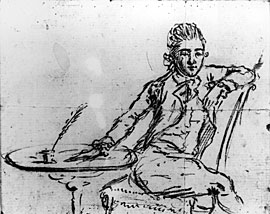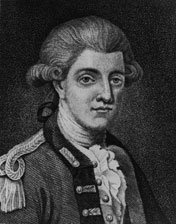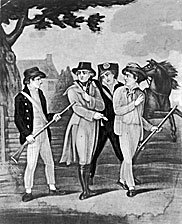Sully painted The Capture of Major André on a canvas slightly smaller than those he typically used for bust-size portraits. In the lower center, four male figures are positioned atop a hill, beneath a large tree, on a dirt road marked with wagon ruts that leads out of the painting at the lower right. A man in a mauve-colored coat is the central, and tallest, figure in the composition. Another man kneels on one knee to this figure’s right, another crouches behind him, and a third stands to his left. Just behind the figures, a saddled horse grazes under a large moss-covered tree, the top of which extends beyond the picture plane. The tree leans slightly to the left, and the soil around its base has eroded, exposing its roots. At the lower left are a leafy green bush and a dirt bank partially covered with dark-brown brush and green grass. A feathered hat, a musket, a black hat, and some scattered papers, including one with a torn red seal, are visible in the grass and dirt. A tree with yellow and brown leaves appears above the dirt bank at the left. Beyond it, water flows in a chasm above which stretch hills, blue-gray mountains, and billowing smoke mingled with pink-edged clouds in a blue sky. Darker clouds show through breaks in the foliage at the upper right. Three of the four men are dressed almost identically in what appears to be a uniform: brown shoes with silver buckles, long olive-green trousers with slits at the cuff and a matching short coat, powder horns, white shirts, and tan hats with feathers. The man crouching behind the figure in the mauve coat does not wear a neck cloth, and his shirt is unbuttoned. Only the kneeling man has placed his hat and musket on the ground. In addition to the long mauve coat, lined with gray silk and trimmed with gold braid and gold buttons, the central figure wears a ruffled white shirt, white stockings, ivory breeches, and a matching waistcoat. On his left foot he wears a black boot trimmed with tan; the kneeling man holds his other boot. He wears a powdered queue wig. Sully carefully delineated his figures’ facial expressions and gestures. The kneeling man looks up in disbelief at the central figure from the spilled contents of the boot. His mouth is slightly open, and his left hand is extended; perhaps he is asking a question. The crouching figure is hunched over, intently reading a document he holds in both hands. The figure in mauve holds a watch in the palm of his right hand and has placed his left hand on the shoulder of the uniformed man standing at his right. Frowning and ignoring the extended watch, the uniformed man gazes outward and upward; he holds a gun in his left hand and clutches papers in his right hand. The two standing figures appear to be in a spotlight, although the brim of the uniformed man’s hat shadows his face. Light coming from the upper left casts shadows from these two standing men. Only the face of the kneeling man is lit, and his body is in shadow, as is the crouching man slightly behind him. The brightest areas of the painting are the mauve coat, ivory breeches and waistcoat, and white ruffled shirt of the central figure, as well as the dirt road. The underdrawing is extensive. Working in pencil, Sully first sketched the figures and elements of the landscape background on the canvas. On top of this drawing, he laid down a thin, semitransparent layer of earth-colored paint. He built up the composition with semitransparent paint layers of varying colors but did not completely cover the underdrawing. For instance, the black outline of the nose, lips, and eyes of the standing uniformed figure is visible beneath a layer of flesh color. Sully applied opaque paint and impasto on the green mossy bark and the yellow-green leaves of the large tree. Near the base of the leaning tree, he signed the canvas with his cipher "TS," followed by the year, "1812." Biography When the three militiamen stopped André, he was in neutral territory, near the British line but not out of danger. Joshua Hett Smith had guided the major to Pine’s Bridge and explained to him that anyone in the neutral territory with property such as horses or other livestock was vulnerable to attack by plundering groups of loyalist "cowboys" or "patriot" skinners.2 Instead of immediately showing his pass from Arnold, André, who thought the three men were Loyalists, unwisely revealed that he was the adjutant general to Sir Henry Clinton, commander-in-chief of the British forces in North America. Supposedly, John Paulding, the group’s leader and a recent escapee from a British prison in New York, was wearing a borrowed green-and-red uniform coat of a Hessian soldier. When André realized his mistake, he belatedly tried to show his pass, but the militiamen were suspicious, searched him, and found the West Point-related documents in his stocking. André was given a military trial in Tappan, New York, sentenced to death, and hung on October 2, 1780. Although some contemporary accounts of the execution express regret about his death, the despised traitor Arnold, who had been alerted to André’s capture in time to escape, received no sympathy. He was hung and burned in effigy, but his behavior during imprisonment won him praise.3 A witness to the events, Caleb Gibbs, recorded in his diary that the Englishman’s final request was that "all the gentlemen present ‘bear witness that he died like a brave man’—& did."4 Benjamin Tallmadge, one of André’s jailers, wrote:
The admiration and sympathy expressed by these Continental officers over the death of a convicted spy inspired other artists as well. Mason Locke Weems’s 1811 edition of The Life of George Washington included an engraving showing André’s capture as one of its seven plates; the author explained why the major could be forgiven.
Even before his capture, John André was a notable figure in Philadelphia. After studying military engineering at the University of Göttingen in Hanover, he came to America with the British Army in 1774.7 When the British surrendered their fort in Quebec in 1775, André was taken prisoner and remained in Lancaster, Pennsylvania, at the home of one Caleb Cope until the end of 1776; while there, André shared his interest in drawing with Cope’s son John. A year later, during the British occupation of Philadelphia, he joined a group of fellow officers in performing theatricals; besides acting, André designed scenery and costumes. He also helped organize "The Mischianza," a weeklong tribute to the departing General William Howe—whom Henry Clinton succeeded as commander-in-chief of British forces—that consisted of a regatta, pageants, mock tournaments, fireworks, and a ball.8 Analysis Both the accompanying exhibition catalogue and George Murray’s review of the annual exhibition in The Port Folio announced Kearny’s plans to publish an engraving of The Capture of Major André as part of a series of single-sheet engravings, each measuring twenty-four by seventeen inches, "to be selected from the most important and interesting subjects in American history."12 Murray himself was responsible for engraving another work in the exhibition; John James Barralet’s drawing First Landing of Columbus in the New World (about 1812) was chosen as the first image in the new series.13 Besides celebrating the young nation’s history, the series was "undertaken with a view to shew the real state of the Arts of Design and Engraving in this country."14 Kearny took subscriptions for his print at his Locust Street address. Although Murray offered criticism of The Capture of Major André, he considered it a "very excellent production," and he intended his comments to benefit the proposed engraving project, in which, of course, he had an interest.15 Murray even praised his fellow engraver Kearny in his review of Sully’s painting: "From a knowledge of the talents and laudable ambition of the young artist, who has undertaken the engraving and publishing a print from this picture; we have every reason to believe that the execution will be such as will do credit to himself, the painter, and our country."16 Surprisingly, however, Kearny’s print of the Major André painting was never published. It was unusual for an engraver to commission a painting from an artist, exhibit it, advertise subscriptions, and then not publish the engraving to recover his costs.17 Certainly, the reputations of both Sully and Kearny would have benefited greatly had it been released. Murray did not engrave Barralet’s design of the First Landing of Columbus in the New World either. Apparently, the proposed series of American history prints was never completed, although other paintings of subjects in that sphere displayed at the 1812 exhibition were engraved.18 The Capture of Major André was valued for its American subject matter above other historical paintings in the European Grand Manner tradition that were included in the 1812 exhibition. The visiting Russian diplomat, artist, and author Pavel Svinin (1788–1839) singled out the work, one of eleven Sully showed at the exhibition, as his "finest painting and the one which best shows his talent."19 And Murray, in his review for The Port Folio, wrote, "This picture is a very excellent production. . . . It is extremely gratifying to the lovers of the fine arts in this country, to see a taste and disposition to encourage historical painting and engraving, by introducing among us a taste for subjects from our own history."20 The portrayal of a Revolutionary War victory of three ordinary Americans over an aristocratic British officer was an inspirational signal to the young republic, which that year had entered another war with England. The didactic message requisite for history painting was clear in The Capture of Major André and was reiterated in the exhibition catalogue, a paraphrase of William Gordon’s explanation as it appeared in his History of the Rise, Progress, and Establishment of the Independence of the United States of America: Including an Account of the Late War and of the Thirteen Colonies from Their Origin to That Period, first published in New York in 1789.
In this excerpt, as in Sully’s image, the captors were praised as heroes for rejecting André’s bribes and doing their patriotic duty. Although he entitled the work The Capture of Major André, Sully did not make the dramatic details of the incident the focus of the image, as did his friend and fellow artist Jacob Eichholtz (1776–1842) in his version of the subject, painted before 1809 (private collection). In Sully’s painting, the three armed and uniformed men have already surrounded André and forced him to dismount.22 The incriminating documents in his boot, revealing his role as a spy, have been discovered. Sully illustrated the moment when John Paulding refuses André’s bribe of a gold watch, thereby emphasizing how "virtue triumphed."
In 1806 the British actor and theater manager Thomas Abthorpe Cooper posed for Sully in Richmond. He convinced the artist to return with him to New York, promising him many portrait commissions.26 That November, Sully set up a "painting room in a part partitioned off from the Coffee room" of the Park Theatre, which Cooper leased.27 He remained there until the following summer, when he traveled to Boston to visit Gilbert Stuart. While in New York, Sully met the artist and writer William Dunlap and may have seen a performance of his play The Glory of Columbia: Her Yeomanry.28 Cooper had acted in an unsuccessful version of that drama, which Dunlap produced in 1798, entitled
The story of Major André and his capture remained apopular subject for painters and engravers for more than a century after the 1780 event.32 Although Kearny did not engrave Sully’s painting, a small, single-sheet mezzotint of the subject was published in Philadelphia by T. W. Freeman on July 4, 1812, two weeks after the Pennsylvania Academy of the Fine Arts exhibition closed. In The Taking of Major André. By the Incorruptible Paulding, Williams and Vanvert (fig 3). the British officer’s face expresses appropriate concern about his predicament, although he still tries to offer Paulding the watch. As in Sully’s painting, Paulding pulls his right arm away, showing his refusal to take the bribe. Freeman celebrated the captors for doing their duty by including their names, along with the word incorruptible, in the title printed beneath the image. Notes 2. Smith 1808, 41–42. 3. Miller 1983, 354–56. André accepted his fate but asked to be shot like a soldier. See Boykin 1934, 16, 17. 4. Caleb Gibbs diary, October 2, 1780, photostat, Massachusetts Historical Society. 5. Major Benjamin Tallmadge, Pines Bridge, to General William Heath, October 10, 1780, William Heath Papers, Massachusetts Historical Society, microfilm reel 17. 6. Weems 1811, 105–6. 7. Lowenberg 1944. 8. Speidel 1987; Cumming and Rankin 1975, 208. 9. Sully’s "Account of Pictures," 1812, frame 16; Sully’s "Journal," April 6, 1812, 14. For Kearny, see DAB X, 1933, 269–70; and Dunlap 1918, II, 362–64. 10. Pennsylvania Academy of the Fine Arts 1811, 20, 21. 11. United States’ Gazette (Philadelphia), April 4, 1812. 12. Pennsylvania Academy of the Fine Arts 1812, 16. 13. Ibid., 4. 14. Ibid., 4, 16. 15. M[urray] 1812, 22. 16. Ibid., 23. 17. The first reference to the publication of the engraving of The Capture of Major André after the initial call for subscriptions in 1812 appeared in 1884. See Scharf and Westcott 1884, II, 1048. However, in 1908, Charles Henry Hart reported that Sully painted The Capture of Major André for Kearney, "who doubtless intended to make a plate from it, but I cannot ascertain that he did so." Hart 1908, 394. Subsequent historians have discussed The Capture of Major André and noted that it was engraved, but none has encountered a print of Sully’s painting. 18. For the engravings made from paintings shown in the exhibition, see Stauffer 1907, II, 376–77; and Biddle and Fielding 1921, 378. 19. Yarmolinsky 1930, 36. 20. M[urray] 1812, 23. 21. Pennsylvania Academy of the Fine Arts 1812, 15–16. 22. The militia uniforms Sully depicts definitely would not have been worn in 1780. According to the historian Michael J. McAfee: "The closed-front, very squared-off tailed coat clearly dates from after 1810 in style, and the looseness of the sleeves and the ‘pegging’ of the trousers seem more like the 1820s to my eye. While no one knows what the famed trio of André captors wore (some even imply one wore a captured British or Loyalist regimental coat), they did not look as they do in this painting." Michael J. McAfee, Curator of History, West Point Museum, to Laura K. Mills, September 13, 1999. 23. Yarmolinsky 1930, 36. 24. M[urray] 1812, 22, 23. 25. Joshua Hett Smith’s book, published in London the year before, contained a similar engraving, André, identified with the following caption: "The Portrait engraved by Hopwood, from a drawing by Major André." Smith 1808, frontispiece. Another of André’s drawings was included in the 1812 annual exhibition and described in the supplement to the catalogue as "A Pencil Drawing by Major John André, while a prisoner at Lancaster, Pennsylvania, in the year 1776. Property of Dr. Barton, to whom it was given by the late Mr. J. Cope, of Lancaster." See Pennsylvania Academy of the Fine Arts 1812, 34. 26. Sully’s "Journal," April 1806, 5. 27. Ibid., December 16, 1806, 5. 28. For Dunlap’s André and The Glory of Columbia: Her Yeomanry, see Meserve 1977, 107–9; Moody 1969, 87–144; and Quinn 1943, 86–88. 29. André opened March 30, 1798, and had only two other performances. Perhaps Dunlap’s play prompted the creation of a three-act pantomime, Death of Major André, and Arnold’s Treachery, or, West Point Preserved, which was staged at Philadelphia’s New-Circus later that spring. See General Advertiser (Philadelphia), May 12, 1798. 30. Moody 1969, 90. 31. For a script of the play, see Moody 1969, 99. 32. One such later work was Asher B. Durand’s The Capture of Major André (1835, Worcester Art Museum), exhibited at the National Academy of Design, New York, the year it was completed. See Minault 1971; Abrams 1995, 54–55, 62, 63; Reynolds 1992, 75–77; and Grafton 1975, 91. |



